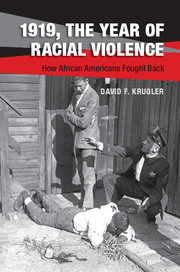Book contents
- Frontmatter
- Dedication
- Contents
- Acknowledgments
- Source Abbreviations and Usage Note
- Introduction
- 1 World War I and the New Negro Movement
- 2 “We Return Fighting”
- 3 Fighting a Mob in Uniform
- 4 Blood in the Streets
- 5 Armed Resistance to the Courthouse Mobs
- 6 Armed Resistance to Economic Exploitation in Arkansas, Indiana, and Louisiana
- 7 “It Is My Only Protection”
- 8 The Fight for Justice
- 9 The Fight for Justice
- 10 Fighting Judge Lynch
- Conclusion
- Bibliography
- Index
- References
4 - Blood in the Streets
Armed Resistance in Chicago
Published online by Cambridge University Press: 05 December 2014
- Frontmatter
- Dedication
- Contents
- Acknowledgments
- Source Abbreviations and Usage Note
- Introduction
- 1 World War I and the New Negro Movement
- 2 “We Return Fighting”
- 3 Fighting a Mob in Uniform
- 4 Blood in the Streets
- 5 Armed Resistance to the Courthouse Mobs
- 6 Armed Resistance to Economic Exploitation in Arkansas, Indiana, and Louisiana
- 7 “It Is My Only Protection”
- 8 The Fight for Justice
- 9 The Fight for Justice
- 10 Fighting Judge Lynch
- Conclusion
- Bibliography
- Index
- References
Summary
“There has been considerable negro hunting today, and considerable excitement in some sections of the city. Some sniping.”
– Major General Leonard Wood’s diary entry about Chicago, July 29, 1919.Michigan and Wabash Avenues were a sea of spectators on February 17, 1919. Several hundred thousand Chicagoans amassed to cheer the men and officers of the 370th Regiment, Ninety-third Division, the black unit better known locally as the Eighth Illinois National Guard. The regiment had just returned from France, where its men had earned the nickname the “Black Devils” from the Germans for their tenacity in combat. Disembarking at the La Salle Street station, the troops “greeted the city with a whoop – the kind that caused the blood to curdle in the Germans’ veins.” In formation the men marched several blocks to a coliseum, where a crowd of 60,000 kept up the adulations. A host of high-ranking army officers feted the men, praising their bravery and sacrifices. A call to remember the dead evoked tears. Mayor William “Big Bill” Thompson’s surprise appearance drew cheers – he was popular with Chicago’s black voters. When he shouted “that justice and equality of citizenship…shall open the doors of opportunity to you,” the crowd roared its approval.
No one could deny that the “Old Eighth” – the only American unit fully commanded by black officers during the Great War – had done its part to make the world safe for democracy. In September 1918, Company F had seized the Hindenburg Cave, a German headquarters at Mont des Signes. Sergeant Matthew Jenkins and his men charged 150 yards to besiege the heavily defended prize. Lacking food and water, Company F withstood several counterattacks during the next two days. In one of the war’s last battles, Company C routed an enemy artillery and machine gun position, earning its soldiers the French Croix de Guerre.
- Type
- Chapter
- Information
- 1919, The Year of Racial ViolenceHow African Americans Fought Back, pp. 99 - 130Publisher: Cambridge University PressPrint publication year: 2014



